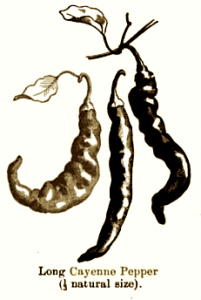 Besides the Piper nigrum there are many varieties of pepper in use among the natives of the countries where they grow; of these, that best known to us is called Cayenne pepper. The plant Capsicum, from which this spice is procured, is a native of both the East and West Indies, but the variety named Capsicum baccatum, or bird pepper, which is the most pungent, is found in the West Indies only. From tins, the best, Cayenne pepper is prepared in the following manner. The ripe fruit, after having been well dried in the sun, is put into an earthen or stone pot, with a layer of flour between each layer of fruit, and baked in an oven till it is perfectly dried. It is then cleaned from the flour, and beaten or ground into fine powder. To every ounce of this powder a pound of wheat flour is added, and the mixture made into small cakes with leaven; these are baked, cut into small pieces, and baked again till they are as hard as biscuit, then beaten into powder and sifted. It is then put into bottles closely corked: this is our best Cayenne pepper.
Besides the Piper nigrum there are many varieties of pepper in use among the natives of the countries where they grow; of these, that best known to us is called Cayenne pepper. The plant Capsicum, from which this spice is procured, is a native of both the East and West Indies, but the variety named Capsicum baccatum, or bird pepper, which is the most pungent, is found in the West Indies only. From tins, the best, Cayenne pepper is prepared in the following manner. The ripe fruit, after having been well dried in the sun, is put into an earthen or stone pot, with a layer of flour between each layer of fruit, and baked in an oven till it is perfectly dried. It is then cleaned from the flour, and beaten or ground into fine powder. To every ounce of this powder a pound of wheat flour is added, and the mixture made into small cakes with leaven; these are baked, cut into small pieces, and baked again till they are as hard as biscuit, then beaten into powder and sifted. It is then put into bottles closely corked: this is our best Cayenne pepper.
Besides the quantity exported to Europe, a great deal is consumed in the countries which produce it; the natives of the East Indian Islands, who have little taste for black pepper, or the finer spices so abundantly produced in their country, use immense quantities of the Capsicum; the consumption of which is as universal as that of salt. It has been supposed, from the word Chili being sometimes applied to the Capsicum by the European merchants of Amboyna [Ambon Island], that the plant is of American origin; but no such name is known in any genuine dialect of the Archipelago; it is indigenous in most of the islands, and is called by different names in the different languages; in Javanese it is Lombok, in the Malay dialect Chabai, and in the Bali, Tabia. In the less populous districts, the Capsicum is cultivated in gardens; but in the more populous, in fields. The Capsicum annuum, the most common variety, is a hardy plant that will grow almost anywhere; its size is increased by culture, but, as in the case of many other berries its pungency is diminished.
This plant is cultivated also in Spain, Portugal, and the south of France; in Languedoc and Provence, the fruit is eaten green, without being cooked; and in that state it is also pickled and used instead of capers. The fruit of the Capsicum grossum, a native of the Indies, is also used for pickling; the skin being more tender and fleshy than in the other species. In the East Indies the dried pods of the different kinds of Capsicum are mixed together, and form an inferior sort of Cayenne pepper; it is in this manner that it is so much used by the natives.
From Anon., The Magazine of Domestic Economy, Volume 1. London: W.S. Orr & Company, 1836.




